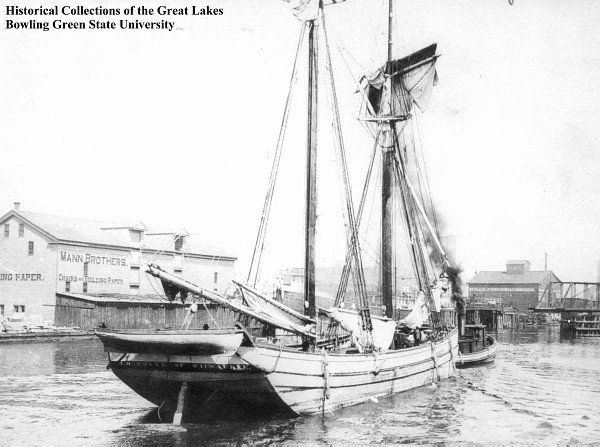Shipwrecks of the Great Lakes: The Rockaway, Michigan’s Underwater Preserves, and the Michigan Maritime Museum
From 7/7/22 to 7/13/22 you can get a free 386-page PDF of Exploring Michigan’s Sunset Coasts. Go to author Julie Royce’s website at www.jkroyce.wordpress.com. Click the button on the sidebar and provide your email. Your email will be deleted once the book is sent. If you like the book, tell your friends and suggest they get the free PDF or buy the book on Amazon. Better yet, if you like it, write a review on Amazon. Let’s promote Michigan!
The approximate 6,000 ships that have succumbed to raging storms attest to the power of the Great Lakes. As I traveled, writing and compiling information for my three-volume travel series, Exploring Michigan’s Coasts, I heard or read the tales left behind by those ill-fated ships. They add a somber, but compelling backdrop to Michigan’s waterways.
The Wreck of the Rockaway
The 106-foot-long lumber schooner Rockaway was lost in a storm off South Haven on November 19, 1891, while sailing from Ludington to Benton Harbor. Built in 1866, the Rockaway was a scow, a vessel designed with a broad flat bottom for stability. Respected as a workhorse, she spent her time carrying wood products, coal, salt, produce, grain, and packaged goods between the lakes.

Learn more: https://www.michiganshipwrecks.org/shipwrecks-2/shipwreck-categories/shipwrecks-found/rockaway
In 1880, the Rockaway was transferred to Muskegon, where she was devoted solely to the Lake Michigan lumber industry. Michigan is notorious for its brutal storms of November, and it was the Rockaway’s ill fortune to sail directly into one. The captain, first mate, and crew of four stayed with their damaged vessel until they had no recourse but to abandon ship or go down with her. All six aboard were rescued. The bones of the Rockaway rest in 70 feet of water, 2½ miles northwest of South Haven.
The wreck of the Rockaway was not discovered for almost a century—and then only by accident—when in 1983 the anchor of two fishermen became entangled in an underwater obstruction. To their surprise, the obstacle was the Rockaway. The wreck was reported to the Michigan Maritime Museum and became an important archaeological site. The wreck is broken into three major pieces on a level plane in approximately 65 feet of water. Sand waves often expose and bury parts of the Rockway’s wreckage. Sand waves are defined as a lower regime sedimentary structure that forms across from underwater currents. The Rockway is now a popular dive site.

From the Michigan History Center: On the 2nd floor of the Michigan History Museum, we display the anchor from the scow-schooner Rockaway. The Rockaway was hauling lumber from Ludington to Benton Harbor when it went down off the coast of South Haven on November 19, 1891. All hands were rescued. Nearly 92 years later, on September 29, 1983, the remains of the schooner were discovered in 70 feet of water by a charter fishing boat that had dropped anchor above the wreck. The fishermen reported the wreck to the Michigan Maritime Museum, which launched six seasons of fieldwork in cooperation with the Michigan Bureau of History and the Department of Natural Resources. Underwater archaeologists recorded the wreck’s history and conserved many of its remains using chemical baths and freeze-drying. The excavation and analysis have made many contributions to our knowledge of Great Lakes scow schooner construction and life aboard such a ship. This noteworthy undertaking was the first complete underwater archaeological excavation of a shipwreck on the American side of the Great Lakes.

Fascinating artifacts recovered from the wreck of the Rockaway, via Michigan Maritime Museum
Michigan Maritime Museum
260 Dyckman Avenue, South Haven, Michigan, (269) 637-8078
Hands-on and interactive exhibits about the people who sailed the Great Lakes. There are five buildings in the complex. One exhibit includes a gallery collection entitled Sailing through Time. Two U. S. Coast Guard buildings display period rescue equipment and three wooden rescue craft. The Boat Shed hosts workshops on shipbuilding and sailing. Visitors are invited to ask questions, watch the work being conducted, and offer a hand if they are inclined.
You can climb aboard a replica of the historic sloop, the Friends Good Will. The original Friends Good Will was built in Detroit in 1810 as a merchant vessel. The sloop was chartered by the federal government to take military supplies to Fort Dearborn at what is now Chicago. She was returning with furs and skins when lured into the Harbor of Mackinaw Island by the British who confiscated the ship and her cargo. She was renamed Little Belt and pressed into service fighting for the Royal Navy until 1813. A ninety-minute sailing experience you are not likely to forget awaits you. You can also take a sunset sail.
Another celebrity of the museum’s fleet is Coast Guard Motor Lifeboat 36460 which was built in 1941 and served for 35 years. A self-bailing and self-righting workhorse, she handled icy conditions and waves up to 60 feet high. A special feature was her watertight survivors’ cabin. In 2012, Disney Productions started work on a new film, The Finest Hours, the true story of the Pendleton rescue. Disney asked to use 36460 in the movie. After Hollywood and her moment in the spotlight, 36460 returned to the MMM and remains one of the stars of its fleet.
Learn more: https://www.michiganmaritimemuseum.org/
Michigan's Underwater Preserves
Michigan’s thirteen underwater preserves include more than 7,000 square miles of Great Lakes bottomland. Sport divers worked for legislation to preserve the state’s underwater resources and legislation was passed in 1980 designating Michigan’s first underwater preserve.
These cold, fresh, underwater museums give us time capsules recording the history of shipping. The 13 preserves are: Alger Underwater Preserve, De Tour Passage Underwater Preserve, Grand Traverse Bay Bottomland Preserve, Keweenaw Underwater Preserve, Manitou Passage Underwater Preserve, Marquette Underwater Preserve, Sanilac Shores Underwater Preserve, Southwest Michigan Underwater Preserve, Straits of Mackinac Shipwreck Preserve, Thumb Area Bottomland Preserve, Thunder Bay National Marine Sanctuary and Underwater Preserve, West Michigan Underwater Preserve, and Whitefish Point Underwater Preserve.
The wrecks contained in these preserves range from shallow enough to explore by snorkeling or aboard a glass bottom boat to deep dive sites for experienced divers. Removal of artifacts from any of the preserves is a felony.
Learn more: http://www.michiganpreserves.org
Click through to read excerpts from Royce's three books exploring Michigan's coasts:
Julie Albrecht Royce, the Michigan Editor for Wandering Educators recently published a three-book travel series exploring Michigan’s coastlines. Nearly two decades ago, she published two traditional travel books, but found they were quickly outdated. This most recent project focuses on providing travelers with interesting background for the places they plan to visit. Royce has published two novels: Ardent Spirit, historical fiction inspired by the true story of Odawa-French Fur Trader, Magdelaine La Framboise, and PILZ, a legal thriller which drew on her experiences as a First Assistant Attorney General for the State of Michigan. She has written magazine and newspaper articles, and had several short stories included in anthologies.

All books available on Amazon.



















